NFT and RWA are the main application scenarios built by non-cryptographic native companies and institutions in the Ethereum ecosystem.
Written by Christine Kim, Vice President of Galaxy Research
Compiled by: Luffy, Foresight News
More than 50 non-cryptocurrency native companies have built products and services on Ethereum or the Ethereum Layer 2 Network (L2). From fashion giants such as Louis Vuitton and Adidas to financial leaders such as Deutsche Bank and PayPal, the innovative practices of these companies are reshaping the landscape of the encryption field. It is worth noting that the crypto businesses of these traditional large companies do not focus on general market infrastructure such as cryptocurrency trading, custody, auditing and compliance, but instead focus on specific infrastructure and application scenarios in the crypto field, such as non-homogeneous tokens (NFT), real-world assets (RWA), Web3 developer tools, and second-layer networks. Among the 20 financial institutions building specific crypto infrastructure and applications, banks account for 10, and most are actively issuing real-world assets on Ethereum. This report aims to conduct an in-depth analysis of Ethereum’s pioneering and leading application scenarios among traditional enterprises and institutions.
profile
In this report, the cryptocurrency industry can be mainly subdivided into three major sectors:
-
Universal infrastructure: Companies that provide cryptocurrency and blockchain-related products and services that are not unique or exclusive to the crypto industry, such as general market infrastructure (e.g., exchanges, market makers, asset management) and general business support (e.g., banking, accounting, consulting, compliance).
-
Crypto-specific infrastructure: Companies that provide products and services unique and exclusive to the encryption industry. For example, companies involved in mining, pledging, and building on-chain oracle machines build infrastructure tailored to the cryptocurrency and blockchain fields.
-
Cryptographic scenarios and applications: Companies that build consumer-grade applications that run in whole or in part on blockchain. For example, decentralized exchanges can automatically perform cryptocurrency transactions on the blockchain without relying on third-party intermediaries.
Today, traditional companies are no longer limited to expanding existing application and service suites to support cryptocurrencies, but are actively innovating new products and services that can only be achieved through blockchain. In addition, at least 55 of these companies are building on public blockchains such as Ethereum and Ethereum Layer 2 networks such as Polygon, Arbitrum and Base.
Here is a market map of 55 non-crypto-native companies that have built on Ethereum or Ethereum Layer 2 networks, or are building crypto-specific infrastructure and applications.
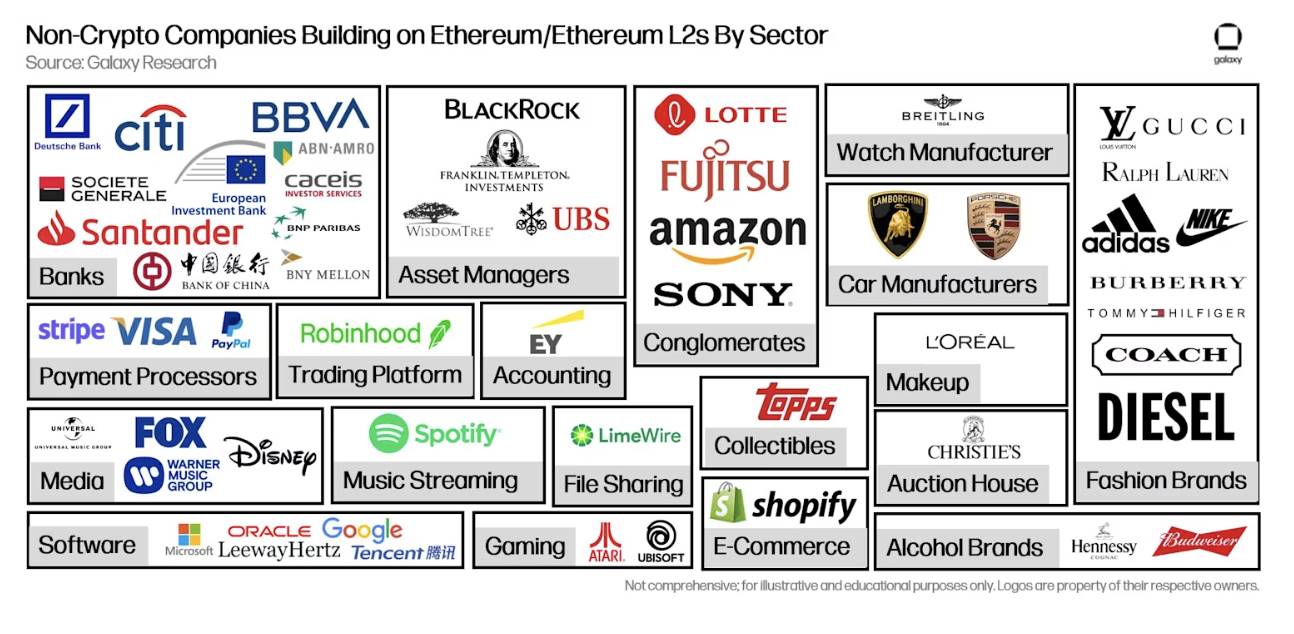
Of the 55 companies on the list, at least 23 publish NFTs on Ethereum or Ethereum’s Layer 2 network.
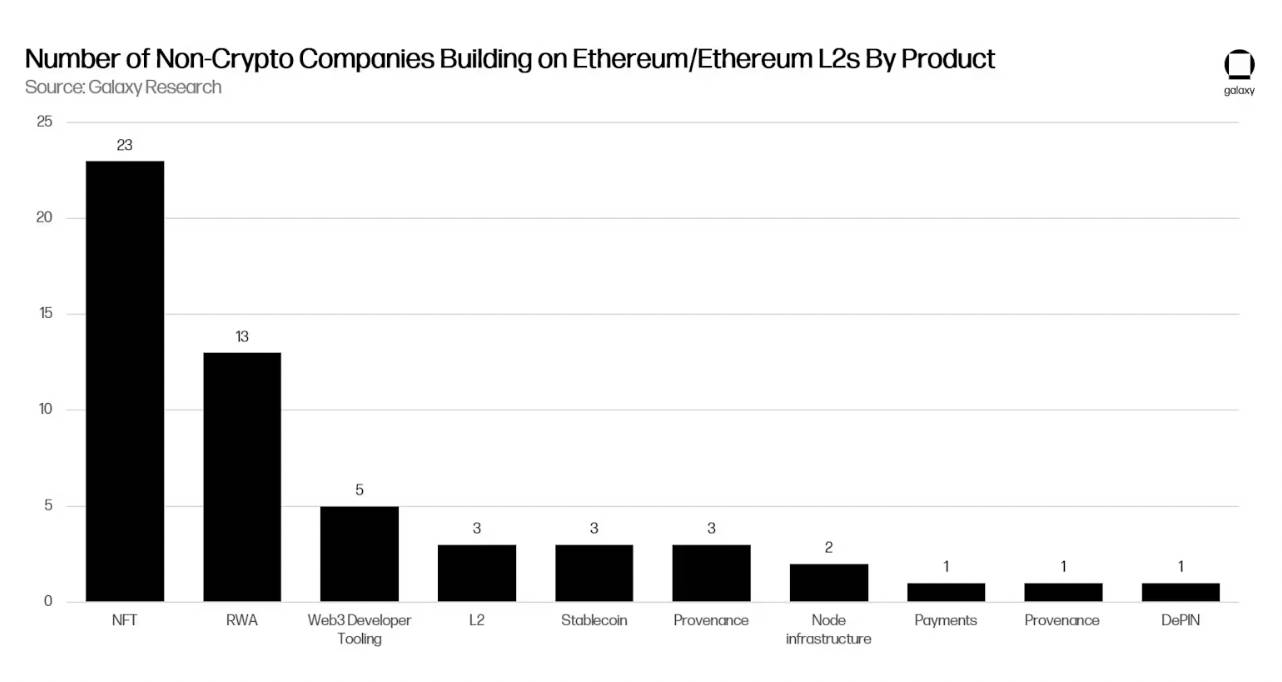
Although most companies build directly on Ethereum, at least 17 have or are exploring multiple generic blockchains and L2.
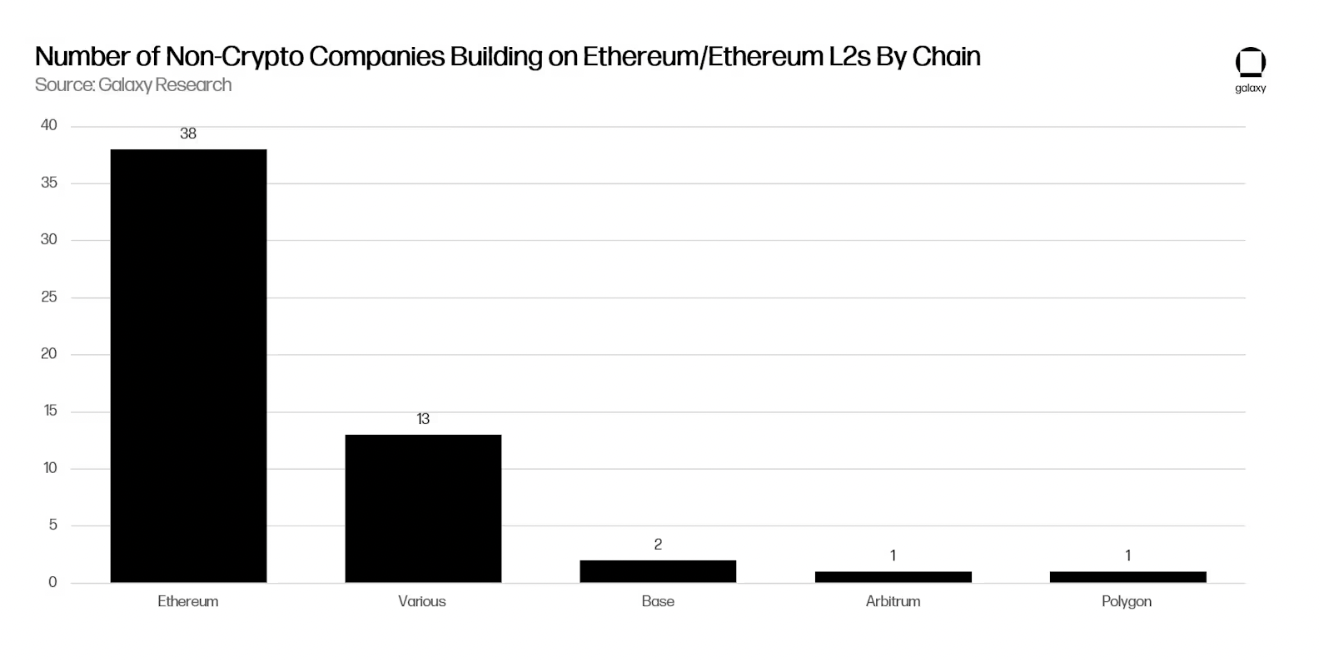
Real-World Assets on Ethereum (RWA)
One of the common types of non-crypto companies doing business in the Ethereum ecosystem is financial institutions such as banks, asset management companies, payment processors, trading platforms, and accounting firms. Of the 20 financial institutions that have been identified as building crypto-specific infrastructure and applications, 13 are issuing real-world assets on Ethereum and Ethereum L2. The types of real-world assets that have been issued on the chain are diverse, including government bonds issued by the Franklin OnChain U.S. Government Money Fund to the European Investment Bank.
Ethereum is the preferred blockchain for issuing tokenized assets, and the total value of its real-world assets is almost ten times that of Stellar, the second most popular real-world asset blockchain. ZKsync is an Ethereum organization L2 network, and the number and total value of real-world assets issued on the chain are higher than Stellar. Six of the top ten networks that issue real-world assets are Ethereum or Ethereum L2.
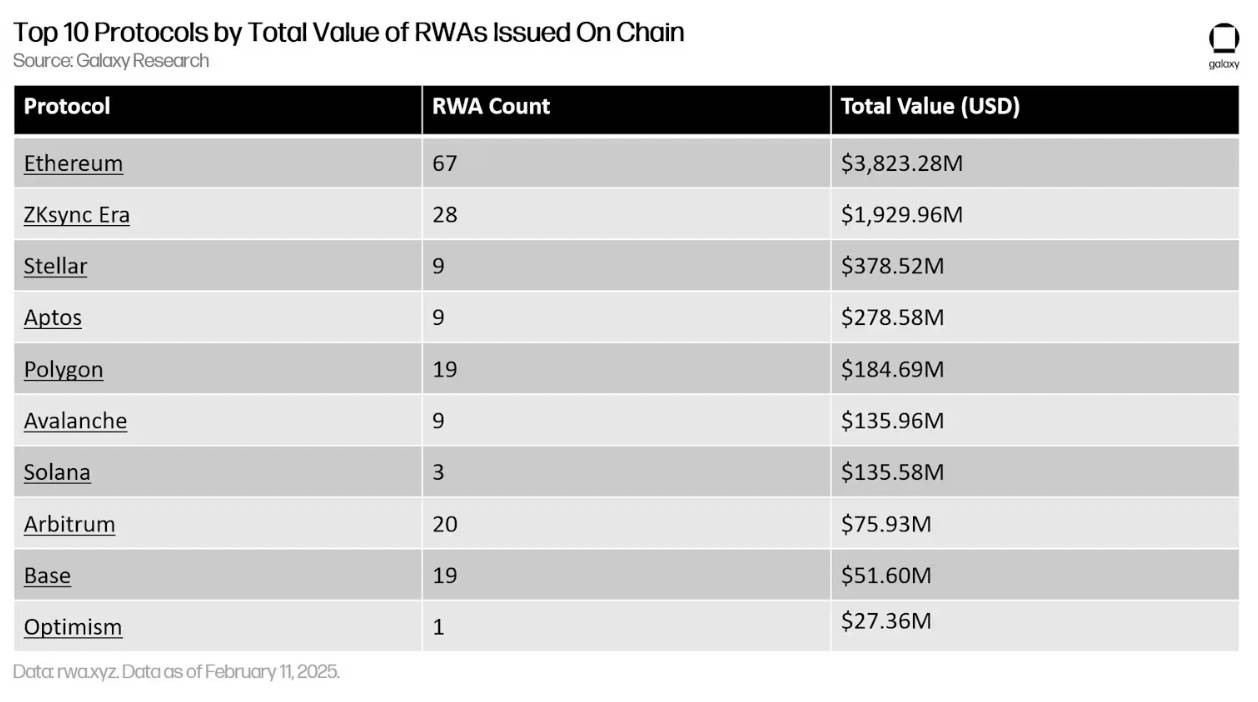
As of February 11, 2025, the third largest tokenized fund among all blockchains is BlackRock’s Dollar Institutional Digital Liquidity Fund (BUIDL). Launched in March 2024, the fund provides investors with U.S. dollar returns and has the advantages of instant, transparent settlement and interoperability between traditional financial markets and decentralized financial markets. Robert Mitchnick, head of digital assets at BlackRock, said in March last year: “Through tokenization, we are packaging traditional financial investment exposure into a crypto-native shell.”
BlackRock, the world’s largest asset manager, partnered with tokenization platform Securitize and U.S. financial services company Bank of New York Mellon to first launch BUIDL on Ethereum. Since March last year, BlackRock has expanded the fund to five more networks outside Ethereum, three of which are Ethereum L2.
The value of real-world assets issued on Ethereum has tripled in the past year. According to rwa.xyz, there are more than 160 real-world assets published on Ethereum, distributed among 60,000 active wallet addresses. This does not include stablecoins.
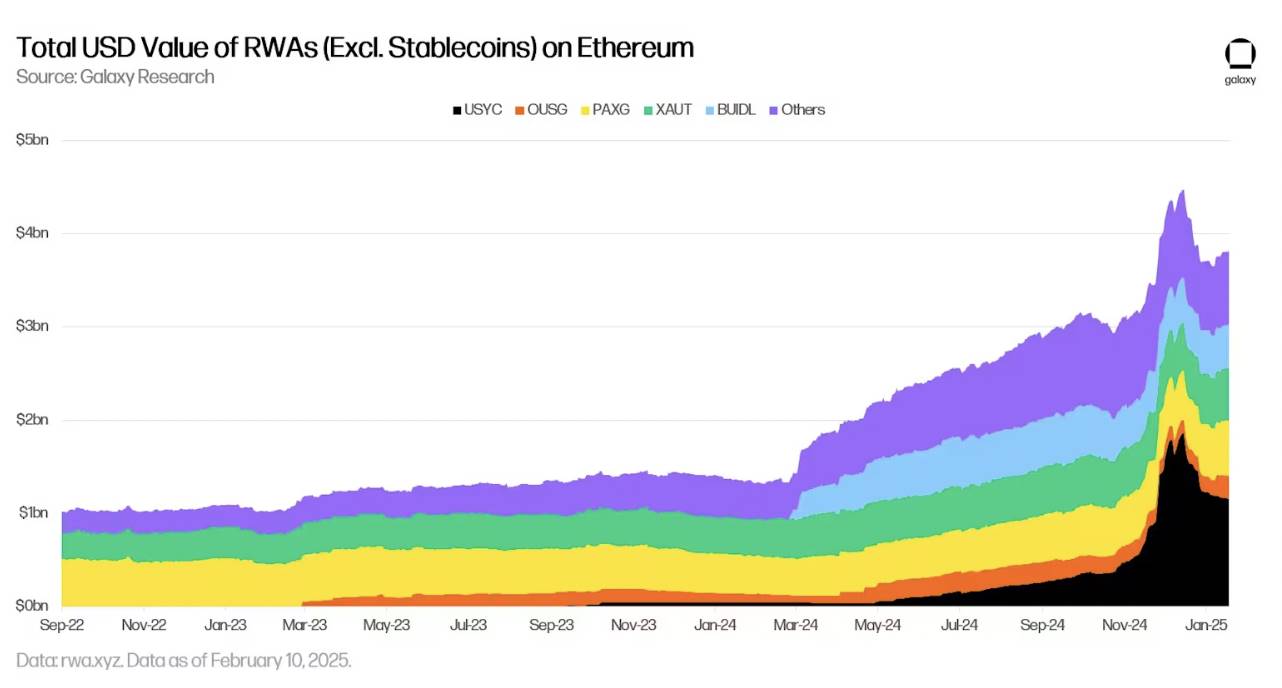
Although the number is small, some financial institutions engaged in real-world asset and tokenization are also developing their own stablecoins. Payment processor PayPal first launched PYUSD, a stablecoin pegged to the US dollar, on Ethereum in August 2023. Since then, PayPal has expanded PYUSD distribution to Solana. Trading platform Robinhood partnered with a series of crypto-native institutions including Galaxy Digital, Kraken, Nuvei, Anchorage, Bullish and Paxos to launch its own stablecoin USDG, pegged to the U.S. dollar, on Ethereum in November 2024.
The total circulation supply of stablecoins on Ethereum has increased by 70% over the past year. These stablecoins vary in collateral combinations and design types, but the vast majority are dollar-pegged instruments and are collateralized with high-quality liquid assets. As of February 11, 2025, Ethereum accounted for more than 50% of the total stablecoin market share.
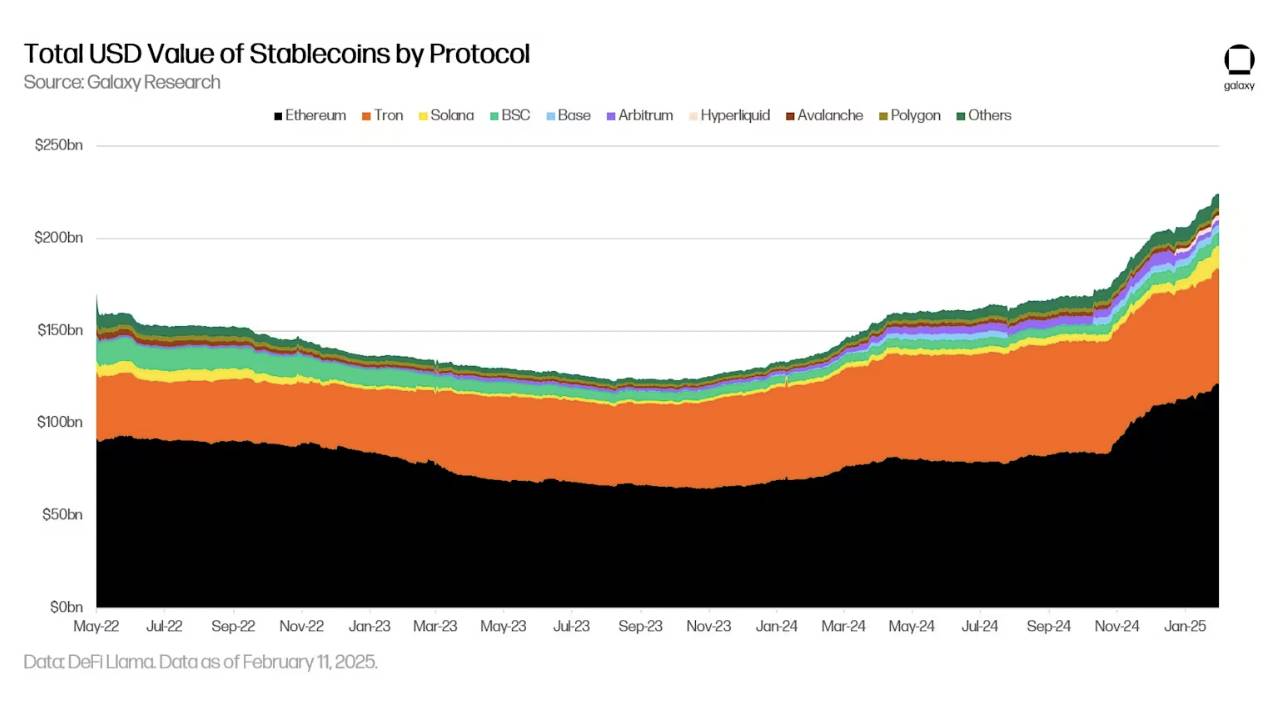
According to Galaxy Research, the total supply of stablecoins is expected to double in 2025 to exceed US$400 billion. A catalyst for accelerating the launch of new stablecoins by traditional financial institutions this year is the acquisition of stablecoin payment platform Bridge for US$1 billion in 2024. Regarding the acquisition, Stripe CEO Patrick Collison said: “Stabiloins are room-temperature superconductor in financial services. Thanks to stablecoins, global companies will achieve significant improvements in speed, coverage and cost in the next few years.”
In the United States, another catalyst for real-world asset and stablecoin adoption is the regulatory environment. U.S. Securities and Exchange Commission (SEC) Commissioner Hester Peirce issued a statement on Tuesday, February 4, 2025, outlining specific priorities and themes that the SEC may address for the digital asset industry, with the ninth item emphasizing the modernization of traditional finance through tokenization. The statement said: “The task force also plans to study the intersection of cryptocurrencies with clearing house and transfer agent rules. We will continue to work with market participants interested in tokenizing securities or otherwise using blockchain technology to modernize traditional financial markets.”
Real-world assets and stablecoins are native crypto application scenarios and are quickly finding a fit between products and markets in traditional financial institutions. As the universal blockchain with the highest degree of decentralization, the widest coverage of crypto native users, and the longest network uptime record, Ethereum is the gateway used by many institutions to incubate and launch finance-focused crypto services and products.
Scalable blockchain infrastructure
Although Ethereum is the gateway for many financial institutions and non-crypto-native companies to adopt cryptocurrency and blockchain technology, it is not a scalable protocol for new blockchain application scenarios. Compared with blockchains such as Solana, Ethereum has poor performance, slower block-out time, and higher transaction costs. Ethereum protocol developers are unwilling to sacrifice the resilience and security of the network for speed, but are committed to extending Ethereum through L2. The expansion solution is a blockchain infrastructure that can inherit the security of Ethereum and expand to millions of new users.
Non-crypto native companies are not only promoting crypto application scenarios on Ethereum, such as tokenization, but are also investing in the infrastructure needed to support these application scenarios to reach a wider audience than crypto native users. Deutsche Bank, Germany’s largest bank, is working with Matter Labs, which built the ZKSync expansion solution, to develop a new expansion solution on Ethereum. The expansion plan, code-named DAMA2, is part of a broader initiative led by the Monetary Authority of Singapore (MAS) and 24 other financial institutions around the world to explore the application scenarios of public blockchain in global finance.
Deutsche Bank’s main motivation for developing the L2 network was to create a blockchain infrastructure that is scalable, auditable, transparent and interoperable with regulated platforms and financial services. Alex Gluchowski, co-creator of ZKSync, said of Deutsche Bank’s motivation for developing the L2 network: “Institutions that want to build on-chain chose ZKSync because it can build in Web3 without compromise. ZKSync provides organizations with a customizable architecture to build tailor-made solutions that achieve privacy protection, scalability, and interoperability with other private and public blockchains.”
Financial institutions like Deutsche Bank are developing blockchain infrastructure on Ethereum that is scalable, customizable and compliant with regional regulations. However, the appeal of scalable and customizable blockchain infrastructure is not limited to financial application scenarios.
Japanese company Sony recently launched its own expansion plan using the OP technology stack on Ethereum. Their motivation for creating and operating their own universal expansion solution is to support a broader ecosystem of games, finance and entertainment applications. Regarding Sony’s L2 network Soneium, Jun Watanabe, chairman of Sony’s Blockchain Solutions Laboratory, said: “I believe that developing a comprehensive Web3 solution based on blockchain is of great significance to the Sony Group. Sony adheres to the purpose of ‘injecting emotion into the world with the power of creativity and technology’ and has carried out a wide range of businesses.”
Since Soneium’s launch, the agreement has faced strong opposition due to Sony’s regulation of on-chain activity, particularly token transfer restrictions and address blacklists. While the incident raises questions about the degree of control companies should have over expansion plans built on permission-free infrastructure such as Ethereum, it also highlights the determination of one of the world’s largest conglomerates to find answers to these questions. Sony has invested in new digital experiences and applications through the launch of expansion solutions on Ethereum, which fully demonstrates the potential value of the Ethereum blockchain space and L2.
Games on the Ethereum L2 network
NFT is the main application scenario for traditional companies, with participants including luxury fashion brands such as Louis Vuitton and Coach, as well as luxury car manufacturers such as Porsche and Lamborghini. Most of the NFTs issued by these companies occurred during the peak of the NFT boom from 2021 to 2023. Given the ebb tide of NFTs in the past few years, many companies will no longer publish NFTs on Ethereum and Ethereum L2 networks in 2025.
The few companies that are still actively publishing NFTs on Ethereum in 2025 are almost all doing so in the context of game development and almost entirely on the Ethereum L2 network rather than the Ethereum main network.
In July 2024, video game giant Atari deployed two of its classic arcade games,”Asteroid” and “Breaking Brick”, on the Ethereum L2 network Base operated by Coinbase. Before the end of August 2024, gamers can earn rewards, cast exclusive Atari NFT, and redeem physical goods on Base. A few months after Atari entered chain games, in October 2024, Lamborghini announced a partnership with Web3 game company Animoca Brands to launch a digital collectibles platform called FastForWorld.
FastForWorld enables gamers to buy, sell and drive Lamborghini cars in a range of games developed by Animoca Brands, including Torque Drift 2, REVV Racing, Auto Universe Center, and FastForWorld’s exclusive experiences.

FastForWorld’s in-game assets are minted on Base. The first version of the platform was launched on November 7, 2024 and is still under active development, with more extensions to the FastForWorld platform expected to be announced in 2025.
Recently, on January 7, 2025, Lotte Group, one of South Korea’s top five corporate groups, announced that it has established a more in-depth cooperation relationship with the Arbitrum Foundation and Offchain Labs to build Lotte’s meta-universe game platform “Caliverse” on the Ethereum L2 network Arbitrum. Caliverse is already online, allowing users to shop, participate in virtual concerts and play games on the platform. Kima Kim, CEO of Caliverse, said when talking about the cooperation with Arbitrum: “We are very happy to work with the most trusted blockchain Arbitrum, to take the first step into the blockchain world. Through Lotte Caliverse, we will leverage Lotte’s successful history in the retail field to provide superior products and services to more than 40 million people.” During the 2025 International Consumer Electronics Show in Las Vegas, USA, the Caliverse team announced plans to launch virtual reality and 3D movie capabilities on its platform in the first half of 2025.

The most notable thing about the continued investment and development of NFTs by non-crypto native companies like Atari, Lamborghini and Lotte’s Caliverse is that they are in the context of on-chain gaming applications. Blockchain-based games may require frequent on-chain transactions, which can lead to high fees and network congestion. As a result, these companies are building games on the Ethereum L2 network to take advantage of the scalability benefits of Ethereum’s L2-centric architecture.
Steven Goldfeder, co-founder and CEO of Offchain Labs, said: “Because the Arbitrum blockchain has an industry-leading 250-millisecond block time and can support seamless virtual worlds and game application scenarios, it is the ideal home for Caliverse.”
conclusion
NFT and real-world assets are the main use scenarios for Ethereum in non-crypto-native companies and organizations. Among the companies publishing NFTs on the Ethereum Ecosystem, the most active company in 2025 will publish NFTs in the context of on-chain game applications built on the Ethereum L2 network. This highlights how the scalability of L2 networks can help support crypto-native application scenarios, such as games in large retail brands and enterprises that require frequent on-chain interactions. Ethereum’s commitment to expanding its infrastructure through expansion solutions also provides an opportunity for early technology adopters in traditional finance and other industries to lead the non-speculative use of cryptocurrencies by creating customizable and compliant infrastructure for these application scenarios. Finally, Ethereum remains the preferred blockchain for traditional financial companies to issue real-world assets and stablecoins. Key partnerships established in 2024 are expected to drive new progress in the adoption of stablecoins in 2025.
Welcome to join the official social community of Shenchao TechFlow
Telegram subscription group: www.gushiio.com/TechFlowDaily
Official Twitter account: www.gushiio.com/TechFlowPost
Twitter英文账号:https://www.gushiio.com/DeFlow_Intern



